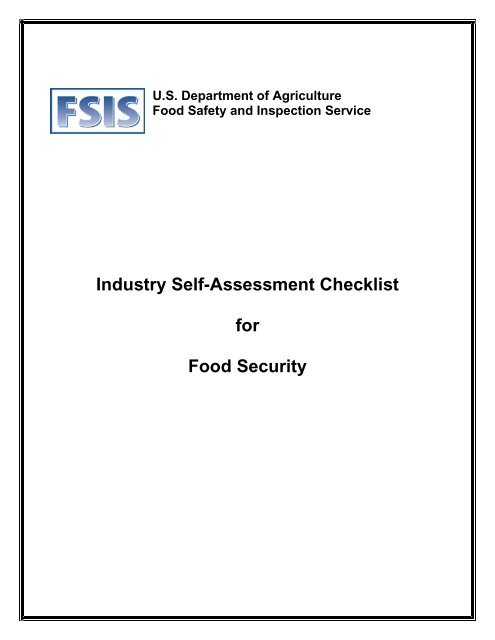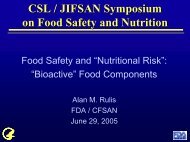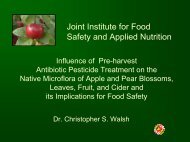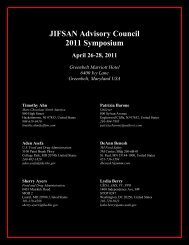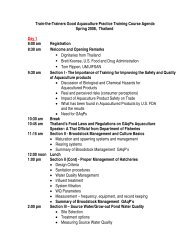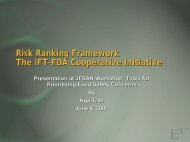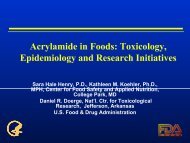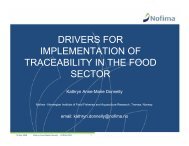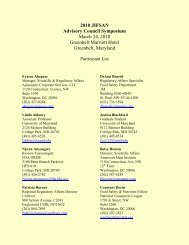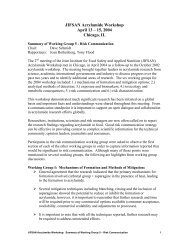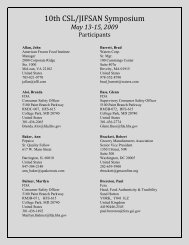Industry Self-Assessment Checklist for Food Security
Industry Self-Assessment Checklist for Food Security
Industry Self-Assessment Checklist for Food Security
You also want an ePaper? Increase the reach of your titles
YUMPU automatically turns print PDFs into web optimized ePapers that Google loves.
U.S. Department of Agriculture<br />
<strong>Food</strong> Safety and Inspection Service<br />
<strong>Industry</strong> <strong>Self</strong>-<strong>Assessment</strong> <strong>Checklist</strong><br />
<strong>for</strong><br />
<strong>Food</strong> <strong>Security</strong>
<strong>Industry</strong> <strong>Self</strong>-<strong>Assessment</strong> <strong>Checklist</strong> <strong>for</strong><br />
<strong>Food</strong> <strong>Security</strong><br />
It is vital that all food slaughter and processing establishments, and all import, export, and<br />
Identification Service establishments take steps to ensure the security of their operations.<br />
USDA’s <strong>Food</strong> Safety and Inspection Service (FSIS) created this self-assessment instrument to<br />
provide a tool <strong>for</strong> establishments to assess the extent to which they have secured their<br />
operations. The contents of the instrument are based primarily on the food security guidelines<br />
that FSIS published in 2002, <strong>Food</strong> <strong>Security</strong> Guidelines <strong>for</strong> <strong>Food</strong> Processors, available at<br />
www.fsis.usda.gov. Those guidelines identify security measures that establishments can adopt<br />
to enhance the security of their operations.<br />
The checklist consists of the following (9) sections:<br />
I. <strong>Food</strong> <strong>Security</strong> Plan Management<br />
II.<br />
III.<br />
IV.<br />
Outside <strong>Security</strong><br />
Inside <strong>Security</strong><br />
Slaughter and Processing <strong>Security</strong><br />
V. Storage <strong>Security</strong><br />
VI.<br />
VII.<br />
VIII.<br />
IX.<br />
Shipping and Receiving <strong>Security</strong><br />
Water and Ice Supply <strong>Security</strong><br />
Mail Handling <strong>Security</strong><br />
Personnel <strong>Security</strong><br />
To use the checklist, read each question under each section and check the response that best<br />
describes the food security practice in the establishment. If a question is not applicable, check<br />
“N/A.” For example, if an establishment only conducts processing activities, then questions that<br />
ask about live animals or slaughter operations would not apply. Similarly, if an establishment<br />
only conducts import/export inspection activities, then questions related to processing or<br />
slaughter would not apply. A “Yes” response <strong>for</strong> every question is desirable but not expected<br />
due to the layering of certain security measures. A “No” answer however, should trigger a<br />
critical thought process in establishment operators on what may be a vulnerability or weakness<br />
in their food security strategy. They must make risk management decisions on additional<br />
1
security measures they may need to put in place at the particular operational sector/area of the<br />
establishment covered by the “No” response. For additional security measures that<br />
establishments can take, they may refer to resources and websites listed in Appendix 1.<br />
Resources/websites specific to a section or question are shown at the corresponding<br />
section/question throughout the checklist <strong>for</strong> quick and easy reference. “NA” responses should<br />
be reviewed periodically to validate them against current operations.<br />
The final outcome of this self-assessment should provide establishments with a relative<br />
measure of overall security of their operations and guide them in the development and/or<br />
revision of their food security strategies.<br />
This checklist is one of several outreach ef<strong>for</strong>ts by FSIS to assist the industry to enhance the<br />
security of its regulated food products. Model food security plans are also being developed <strong>for</strong><br />
voluntary use by the industry. The Agency is also considering additional measures that may be<br />
appropriate to ensure the safety and security of meat, poultry and egg products under certain<br />
elevated threat conditions specific to food and agriculture.<br />
I. FOOD SECURITY PLAN MANAGEMENT<br />
A food security plan is a written document developed using established risk management<br />
procedures and consists of specific standard operating procedures <strong>for</strong> preventing intentional<br />
product tampering and responding to threats or actual incidents of intentional product<br />
tampering.<br />
1. Does this establishment have a written food security plan<br />
Yes<br />
No [GO TO QUESTION 4]<br />
2. Which of the following procedures, plans, or in<strong>for</strong>mation are either included in the<br />
food security plan or have been put in place as a result of the food security plan<br />
(Check “Yes” or “No” <strong>for</strong> each item.)<br />
Yes<br />
No<br />
Is there a designated person or team to implement and oversee the food security<br />
plan<br />
Are members of the food security management team trained in all provisions of the<br />
food security plan<br />
Are periodic drills conducted on the operational elements of the food security plan<br />
Are regular food security inspections conducted to verify key provisions of the food<br />
security plan<br />
2
Is the security plan reviewed (and revised if necessary) periodically<br />
Are the details of food security procedures kept confidential<br />
Is the emergency contact in<strong>for</strong>mation <strong>for</strong> local, state, and federal government<br />
homeland security authorities and public health officials included in the security<br />
plan<br />
State contact list: www.whitehouse.gov/homeland/contactmap.html<br />
Is the above contact in<strong>for</strong>mation periodically reviewed and updated<br />
Is there an established liaison between plant officials and the local homeland<br />
security officials and other law en<strong>for</strong>cement officials<br />
Is there an established relationship between the establishment and the appropriate<br />
analytical laboratories <strong>for</strong> possible assistance in investigation of product tampering<br />
cases<br />
Are procedures <strong>for</strong> responding to threats of product tampering included in the plan<br />
Are procedures <strong>for</strong> responding to actual incidents of product tampering detailed in<br />
the plan<br />
http://www.state.tn.us/agriculture/security/fsig.html<br />
Are communication procedures <strong>for</strong> notifying law en<strong>for</strong>cement, public health officials,<br />
and FSIS inspectors in-charge when a food security threat is received or when<br />
evidence of actual product tampering is observed included in the plan<br />
Are procedures in the plan <strong>for</strong> corrective action in cases of product tampering to<br />
ensure that adulterated or potentially injurious products do not enter commerce<br />
Are procedures in the plan <strong>for</strong> safe handling and disposal of products contaminated<br />
with chemical or biological agents<br />
Are employees encouraged to report signs of possible product tampering or breaks<br />
in food security system (e.g., award system)<br />
Are evacuation procedures in the security plan<br />
Visit www.osha.gov/dep/evacmatrix/index.html <strong>for</strong> guidance material provided by the<br />
U.S. Department of Labor, Occupational Safety and Health Administration<br />
Are procedures in place to restrict access to the facility during an emergency to<br />
authorized personnel only<br />
Are designated entry points <strong>for</strong> emergency personnel clearly marked<br />
Does the establishment have a documented recall plan<br />
Are procedures in the recall plan reviewed and updated as necessary<br />
Do recall procedures ensure segregation and disposition of recalled products<br />
Yes<br />
No<br />
3
II.<br />
OUTSIDE SECURITY<br />
3. Which of the following security procedures does this establishment have in place<br />
<strong>for</strong> the exterior of this establishment (Check “Yes” or “No” <strong>for</strong> each procedure.)<br />
Yes<br />
No<br />
Are the plant’s boundaries and grounds secured to prevent entry by unauthorized<br />
persons (e.g., by locked fence or gate)<br />
Are “No Trespassing” signs posted at plant’s boundaries<br />
Is there sufficient outside lighting to allow detection of unusual activities on any<br />
part of the establishment outside premises during non-daylight hours<br />
Do emergency exits have self-locking doors and/or alarms<br />
Is positive identification required to control entry of visitors to the plant (e.g., picture<br />
IDs or sign-in/sign-out at entrance)<br />
Is an updated list of establishment personnel with open or restricted access to the<br />
establishment maintained at the security office or another secure location<br />
4. Are the following secured with locks, seals, or sensors at all times to prevent<br />
entry by unauthorized persons (Check “Yes” or “No” <strong>for</strong> each item, or “N/A” if<br />
the item is not applicable.)<br />
Outside doors and gates<br />
Windows<br />
Roof openings<br />
Vent openings<br />
Trailer (truck) bodies<br />
Tanker truck hatches<br />
Railcars<br />
Bulk storage tanks<br />
Yes No N/A<br />
5. Which of the following security procedures does this establishment have in place<br />
<strong>for</strong> vehicles entering the establishment (Check “Yes” or “No” <strong>for</strong> each<br />
procedure.)<br />
4
Yes<br />
No<br />
Are incoming private vehicles (e.g., employees or visitors) inspected<br />
<strong>for</strong> unusual cargo or activity<br />
Are outgoing private vehicles (e.g., employees or visitors) inspected<br />
<strong>for</strong> unusual cargo or activity<br />
Are incoming commercial vehicles (e.g., delivery trucks) inspected <strong>for</strong><br />
unusual cargo or activity<br />
Are outgoing commercial vehicles (e.g., delivery trucks) inspected <strong>for</strong><br />
unusual cargo or activity<br />
Are incoming tanker truck shipments checked <strong>for</strong> documentation of<br />
chain of custody prior to loading<br />
Are employee vehicles identified using placards, decals, or some<br />
other <strong>for</strong>m of visual identification<br />
Are authorized visitor/guest vehicles identified using placards, decals,<br />
or some other <strong>for</strong>m of visual identification<br />
III.<br />
General inside <strong>Security</strong><br />
6. Which of the following security procedures does this establishment have in place<br />
within the interior of this establishment (Check “Yes” or “No” <strong>for</strong> each<br />
procedure, or “N/A” if the procedure is not applicable.)<br />
Is emergency lighting provided in the establishment<br />
Is active surveillance of the inside facility and operations<br />
maintained<br />
Are emergency alert systems tested periodically<br />
Are the locations of controls <strong>for</strong> emergency alert systems<br />
clearly marked<br />
Are all restricted areas (i.e., areas where only authorized<br />
employees have access) within the plant clearly marked<br />
Are visitors, guests, and other non-establishment<br />
employees (e.g., contractors, salespeople, truck drivers)<br />
restricted to non-product areas unless accompanied by an<br />
authorized establishment employee<br />
Are updated plant layout schematics provided at strategic<br />
and secured locations<br />
Yes No N/A<br />
5
Are procedures in place to check toilets, maintenance<br />
closets, personal lockers, and storage areas <strong>for</strong> concealed<br />
packages<br />
Is a daily inventory of tools and utensils (e.g., knives) used<br />
conducted on a daily basis<br />
Is a daily inventory of keys to secured areas of the facility<br />
conducted<br />
Are ventilation systems constructed in a manner that<br />
provides <strong>for</strong> immediate isolation of contaminated areas or<br />
rooms<br />
7. Are the central controls <strong>for</strong> the following restricted (e.g., by locked door/gate or<br />
limiting access to designated employees) to prevent access by unauthorized<br />
persons<br />
Check “Yes” or “No” <strong>for</strong> each item, or “N/A” if the item is not applicable.<br />
www.cdc.gov/niosh/bldvent/2002-139.html<br />
Heating, Ventilation, and Air Conditioning systems<br />
Yes No N/A<br />
Propane Gas<br />
Water systems<br />
Electricity<br />
Disinfection systems<br />
Clean-in-place (CIP) systems<br />
8. Does this establishment collect and analyze samples in-house<br />
Yes <br />
No [GO TO QUESTION 10] <br />
9. Which of the following security procedures does this establishment have in place<br />
<strong>for</strong> its in-plant laboratory facilities, equipment, and operations (Check “Yes” or<br />
“No” <strong>for</strong> each procedure, or “N/A” if the procedure is not applicable [e.g., this<br />
establishment does not use live cultures of pathogenic bacteria].)<br />
6
Is access to the in-plant laboratory facilities restricted to<br />
authorized employees (e.g., by locked door, pass card,<br />
etc.)<br />
Is a procedure in place to control receipt of samples<br />
received from other establishments<br />
Is a procedure in place to receive and securely store<br />
reagents<br />
Is a procedure in place to control and dispose of reagents<br />
Is a procedure in place to receive and securely store live<br />
cultures of pathogenic bacteria<br />
Is a procedure in place to dispose of live cultures of<br />
pathogenic bacteria<br />
Yes No N/A<br />
10. Does this establishment use a computer system to monitor processing operations<br />
Yes<br />
No [GO TO QUESTION 12]<br />
11. Which of the following security procedures does this establishment have in place <strong>for</strong><br />
its computer systems (Check “Yes” or “No” <strong>for</strong> each procedure.)<br />
http://www.fiu.edu/security.guidelines.html<br />
Yes<br />
No<br />
Is the access to the system password-protected<br />
http://www.umich.edu/~policies/pw-security.html<br />
Are firewalls built into the computer network<br />
Is the system using a current virus detection system<br />
IV.<br />
SLAUGHTER AND PROCESSING SECURITY<br />
12. Which of the following security procedures does this establishment have in place<br />
<strong>for</strong> its slaughter and processing operations (Check “Yes” or “No” <strong>for</strong> each<br />
procedure, or “N/A” if the procedure is not applicable [e.g., this establishment<br />
does not mix or batch ingredients].)<br />
7
Is access to product production/slaughter and holding pen areas<br />
restricted to establishment employees and FSIS inspection<br />
personnel only<br />
Is the mixing and batching of product and ingredients and other<br />
operations where large amounts of exposed product are handled<br />
continuously monitored<br />
Yes No N/A*<br />
Are lines that handle and transfer products, water, oil, or other<br />
ingredients monitored to ensure integrity<br />
Is the packaging integrity of ingredients examined <strong>for</strong> evidence of<br />
tampering be<strong>for</strong>e use<br />
Is the restricted access to in-plant irradiation equipment and<br />
materials clearly marked and maintained<br />
Are records maintained to ensure the capability to trace-back raw<br />
materials to suppliers<br />
Are records maintained to ensure the capability to trace-<strong>for</strong>ward<br />
finished products to vendors<br />
*“N/A” RESPONSE POSSIBLE IN ABOVE SECTION FOR IMPORT, EXPORT, AND ID<br />
ESTABLISHMENTS.<br />
V. STORAGE SECURITY<br />
13. Which of the following security procedures does this establishment have in place<br />
<strong>for</strong> its storage areas (Check “Yes” or “No” <strong>for</strong> each procedure, or “N/A” if the<br />
procedure is not applicable [e.g., this establishment does not use restricted<br />
ingredients].)<br />
Is access to raw product storage areas, including holding coolers<br />
restricted (e.g., by locked door/gate) to designated employees<br />
Is an access log maintained <strong>for</strong> raw product storage areas<br />
Is access to non-meat ingredient storage areas restricted to<br />
designated employees only<br />
Is an access log maintained <strong>for</strong> ingredient storage areas<br />
Yes No N/A<br />
8
Is access to finished product storage areas restricted to designated<br />
employees<br />
Is access to external storage facilities restricted to designated<br />
employees only<br />
Are silo storage tanks <strong>for</strong> raw egg product and other bulk ingredients<br />
(syrup, oils, etc.) maintained under lock and seal<br />
Are silo storage tanks <strong>for</strong> pasteurized egg product and other bulk<br />
finished products maintained under lock and seal<br />
Are silo storage tanks <strong>for</strong> inedible egg product and other bulk inedible<br />
products maintained under lock and seal<br />
Are periodic security inspections of storage facilities (including<br />
temporary storage vehicles) conducted<br />
Are records maintained on facility security inspections results<br />
Is the inventory of restricted ingredients (i.e., nitrites, etc) reconciled<br />
against the actual use of such ingredients on a daily basis<br />
Are product labels and packaging held in a secure area to prevent<br />
theft and misuse<br />
Is the inventory of finished products regularly checked <strong>for</strong> unexplained<br />
additions and withdrawals from existing stock<br />
Yes No N/A<br />
14. Which of the following security procedures does this establishment have in place <strong>for</strong><br />
the storage of hazardous materials/chemicals such as pesticides, industrial<br />
chemicals, cleaning materials, sanitizers, and disinfectants (Check “Yes” or “No”<br />
<strong>for</strong> each procedure.)<br />
Is the access to inside and outside storage areas <strong>for</strong> hazardous<br />
materials/chemicals such as pesticides, industrial chemicals, cleaning<br />
materials, sanitizers, and disinfectants restricted to designated<br />
employees<br />
Are hazardous material/chemical storage areas separated from<br />
production areas of plant<br />
Is a daily inventory of hazardous materials/chemicals maintained<br />
Are discrepancies in daily inventory of hazardous materials/chemicals<br />
immediately investigated<br />
Are the storage areas <strong>for</strong> hazardous materials/chemicals constructed<br />
and safely vented in accordance with national or local building codes<br />
Is a procedure in place to receive and securely store hazardous chemicals<br />
Yes<br />
No<br />
9
Is a procedure in place to control disposition of hazardous chemicals<br />
Yes<br />
No<br />
VI.<br />
Shipping and Receiving <strong>Security</strong><br />
Visit: http://www.fsis.usda.gov/oa/topics/transportguide.htm<br />
15. Which of the following security procedures does this establishment have in place<br />
<strong>for</strong> its shipping and receiving operations (Check “Yes” or “No” <strong>for</strong> each<br />
procedure, or “N/A” if the procedure is not applicable [e.g., no tanker trucks on<br />
premises].)<br />
Are trailers on the premises maintained under lock and/or seal<br />
when not being loaded or unloaded<br />
Are tanker trucks on the premises maintained under lock and seal<br />
when not being loaded or unloaded<br />
Is the loading and unloading of vehicles transporting raw<br />
materials, finished products, or other materials used in food<br />
processing closely monitored<br />
Yes No N/A<br />
16. Which of the following security procedures does this establishment have in place<br />
<strong>for</strong> handling outgoing shipments (Check “Yes” or “No” <strong>for</strong> each procedure, or<br />
“N/A” if the procedure is not applicable [e.g., no tanker trucks on premises].)<br />
Are outgoing shipments sealed with tamper-evident seals<br />
Are the seal numbers on outgoing shipment documented on the<br />
shipping documents<br />
Are tanker trucks inspected <strong>for</strong> indications of the presence of<br />
potential threat agents prior to loading liquid products<br />
Are records maintained of the above inspections of tanker trucks<br />
Are chain-of-custody records maintained <strong>for</strong> tanker trucks<br />
Yes No N/A<br />
17. Which of the following security procedures does this establishment have in place<br />
<strong>for</strong> handling incoming shipments (Check “Yes” or “No” <strong>for</strong> each procedure, or<br />
“N/A” if the procedure is not applicable [e.g., this establishment does not receive<br />
live animals].)<br />
10
Is access to loading docks controlled to avoid unverified or unauthorized<br />
deliveries<br />
Is advance notification from suppliers (by phone, e-mail, or fax) required <strong>for</strong> all<br />
incoming deliveries<br />
Are suspicious alterations in the shipping documents immediately investigated<br />
Are all deliveries verified against the roster of scheduled deliveries<br />
Are unscheduled deliveries held outside facility premises pending verification<br />
Are off-hour deliveries accepted<br />
If off-hour deliveries are accepted, is prior notice of the delivery required<br />
If off-hour deliveries are accepted, is the presence of authorized individual to<br />
verify and receive the delivery required<br />
Is the integrity of internal compartments in the truck, lot packaging, or in-transit<br />
security checks <strong>for</strong> less-than-truckload (LTL) or partial load shipments of<br />
materials verified<br />
Requires incoming shipments of raw product, ingredients, and finished products<br />
to be sealed with tamper-evident seals<br />
Are incoming shipments of raw product, ingredients, and finished products<br />
required to be sealed with numbered seals (and documented in the shipping<br />
documents) which are verified prior to entry<br />
Is the integrity of incoming shipments of raw product, ingredients, and finished<br />
products checked at receiving dock <strong>for</strong> evidence of tampering<br />
Is the FSIS Public Health Veterinarian notified immediately when animals with<br />
unusual behavior and/or symptoms are received<br />
http://www.inspection.gc.ca/english/ops/secur/livbete.shtml<br />
Are the feed and drinking water supplies <strong>for</strong> live animals protected from possible<br />
intentional contamination<br />
Are transportation companies selected with consideration of the procedures<br />
companies have in place to safeguard the security of product/animals being<br />
shipped<br />
Are transportation companies selected with consideration of background checks<br />
conducted on drivers and other employees who have access to product/animals<br />
Are ingredient suppliers selected with consideration of food security measures<br />
implemented by the suppliers<br />
Are vendors of compressed gas selected with consideration of food security<br />
measures implemented by vendors<br />
Are vendors of packaging materials and labels selected with consideration of food<br />
security measures implemented by vendors<br />
Yes No N/A<br />
11
18. Does this establishment allow returned goods, including returns of U.S. exported<br />
products, to enter the plant<br />
Yes <br />
No [GO TO QUESTION 20] <br />
19. Which of the following security procedures does this establishment have in place<br />
<strong>for</strong> returned goods (Check “Yes” or “No” <strong>for</strong> each procedure.)<br />
Are all returned goods examined <strong>for</strong> evidence of possible tampering be<strong>for</strong>e<br />
salvage or use in rework<br />
Are records maintained of returned goods used in rework<br />
Are returned goods reworked/examined at a separate designated location in<br />
the establishment to prevent potential cross-contamination of products<br />
Does the establishment follow the procedures outlined in FSIS Directive<br />
9010.1 <strong>for</strong> return of U.S. exported products<br />
http://www.fsis.usda.gov/oppde/rdad/fsisdirectives/9010-1.pdf<br />
Yes<br />
No<br />
VII.<br />
WATER AND ICE SECURITY<br />
Visit http://cfpub.epa.gov/safewater/watersecurity/index.cfm; <br />
www.epa.gov/region1/eco/drinkwater/pdfs/drinkingH2Ofactsheet.pdf <br />
<strong>for</strong> guidance material from the U.S. Environmental Protection Agency, Water <strong>Security</strong>. <br />
20. Which of the following security procedures does this establishment have in place<br />
<strong>for</strong> its water and ice supply (Check “Yes” or “No” <strong>for</strong> each procedure, or “N/A” if<br />
the procedure is not applicable.)<br />
Is access to water wells restricted (e.g., by locked<br />
door/gate or limiting access to designated employees)<br />
Is access to ice-making equipment restricted<br />
Is access to ice storage facilities restricted<br />
Is access to storage tanks <strong>for</strong> potable water restricted<br />
Is access to water reuse systems restricted<br />
Are potable water lines periodically inspected <strong>for</strong> possible<br />
tampering<br />
Are non-potable water lines inspected <strong>for</strong> possible<br />
tampering (leaks, connected to potable lines, etc.)<br />
Yes No N/A<br />
12
Yes No N/A<br />
Have arrangements been made with local health officials to<br />
ensure immediate notification of the plant if the potability of<br />
the public water supply is compromised<br />
VIII. MAIL HANDLING SECURITY<br />
21. Which of the following security procedures does this establishment have in place<br />
to ensure mail handling security<br />
Is mail handling activity conducted in a separate room or<br />
facility away from in-plant food production/processing<br />
operations<br />
Are mail-handlers trained to recognize and handle<br />
suspicious pieces of mail using U.S. Postal Service<br />
guidelines<br />
http://www.usps.com/news/2001/press/serviceupdates.htm<br />
Yes No N/A<br />
IX.<br />
PERSONNEL SECURITY<br />
22. Which of the following security procedures does this establishment have in place<br />
<strong>for</strong> ensuring that establishment personnel adhere to the security requirements<br />
(Check “Yes” or “No” <strong>for</strong> each procedure, or “N/A” if the procedure is not<br />
applicable [e.g., the establishment does not use contractors].)<br />
Are background checks conducted on new permanent<br />
employees prior to hiring<br />
Are background checks conducted on new temporary,<br />
seasonal, and contract employees prior to hiring<br />
Do all plant employees receive training on security<br />
procedures as part of their orientation training<br />
Are procedures in place to ensure positive<br />
identification/recognition of all establishment employees<br />
Yes No N/A<br />
13
Are identification procedures in place to ensure the positive<br />
identification/recognition <strong>for</strong> temporary employees and<br />
contractors (including construction workers, cleaning crews,<br />
and truck drivers) in the establishment<br />
Are procedures in place to screen employees entering the<br />
plant during working hours<br />
Are procedures in place to screen entry of employees into<br />
the plant during non-working hours<br />
Are procedures in place to screen the entry of contractors<br />
into the plant during working hours<br />
Are procedures in place to screen entry of contractors into<br />
the plant during non-working hours<br />
Are procedures in place to restrict temporary employees<br />
and contractors (including construction workers, cleaning<br />
crews, and truck drivers) to areas of plant relevant to their<br />
work<br />
Are procedures in place to ensure clear identification of<br />
personnel with their specific functions/assignments (e.g.,<br />
colored garb)<br />
Is an updated shift roster of establishment employees<br />
distributed to supervisors at the start of each shift<br />
Is a policy in place on what personal items may and may not<br />
be allowed inside the plant and within production areas<br />
Are announced and unannounced inspections of<br />
employees’ lockers conducted<br />
Are employees and/or visitors restricted on what they can<br />
bring (cameras, etc.) into plant<br />
Are employees allowed to remove company-provided<br />
clothing or protective gear from the premises<br />
Yes No N/A<br />
14
APPENDIX 1 – LIST OF RESOURCES<br />
These resources contain security guidelines applicable to multiple sections of the checklist that<br />
establishments can adopt to enhance their capabilities to prevent intentional product tampering<br />
and to respond to threats or actual incidents of intentional product tampering. Additional<br />
resources with guidelines that apply only to specific sections are shown at appropriate sections<br />
throughout the document <strong>for</strong> easy access and reference.<br />
FSIS “<strong>Security</strong> Guidelines <strong>for</strong> <strong>Food</strong> Processors”<br />
http://www.fsis.usda.gov/oa/topics/<strong>Security</strong>Guide.pdf<br />
World Health Organization (WHO) – “Terrorist Threats to <strong>Food</strong> – Guidelines <strong>for</strong> <br />
Establishing and Strengthening Prevention and Response Systems” <br />
(ISBN 92 4 154584 4) <br />
http://www.who.int/foodsafety/publications/general/terrorism/en/<br />
U. S. <strong>Food</strong> and Drug Administration (FDA) – “<strong>Food</strong> <strong>Security</strong>, Processors, and<br />
Transporters; <strong>Food</strong> <strong>Security</strong> Preventive Measures Guidance”<br />
http://www.cfsan.fda.gov/~dms/secguid6.html/<br />
U.S. <strong>Food</strong> and Drug Administration (FDA)-“ Retail <strong>Food</strong> Stores and <strong>Food</strong> Service<br />
Establishments; <strong>Food</strong> <strong>Security</strong> Preventive Measures Guidance”<br />
http://www.cfsan.fda.gov/~dms/secgui11.html<br />
Center <strong>for</strong> Disease Control and Prevention (CDC), National Institute of Occupational<br />
Safety and Health (NIOSH) –“Protecting Building Environments from Airborne Chemical,<br />
Biological, or Radiological Attacks”<br />
http://www.cdc.gov/niosh/bldvent/2002-139.html<br />
USDA, <strong>Food</strong> and Nutrition Service (FNS)- “A Biosecurity <strong>Checklist</strong> <strong>for</strong> <strong>Food</strong> Service<br />
Programs, Developing a Biosecurity Management Plan”<br />
http://schoolmeals.nal.usda.gov/Safety/FNS<strong>Food</strong>Safety.html<br />
Canadian <strong>Food</strong> Inspection Agency (CFIA) – “Suggestions <strong>for</strong> Improving <strong>Security</strong>”<br />
http://www.inspection.gc.ca/english/ops/secur/protrae.shtml<br />
15
Center <strong>for</strong> Infectious Disease Research and Policy (CIDRAP), Academic Health Center,<br />
University of Minnesota<br />
http://www.cidrap.umn.edu/cidrap/content/biosecurity/food-biosec/guidelines<br />
County of San Diego, Department of Environmental Health, “Guidelines <strong>for</strong> <strong>Food</strong> Safety<br />
and <strong>Security</strong>”<br />
http://www.sdcounty.ca.gov/deh/fhd/pdf/food_safety_security_217.pdf<br />
16


